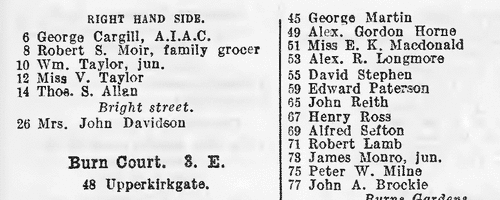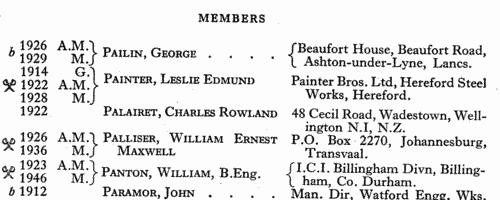Our indexes include entries for the spelling yule. In the period you have requested, we have the following 207 records (displaying 181 to 190):
Residents of Aberdeen: Albert Terrace (1939)
The street directory gives full names (christian and surname, or initials and surname) street by street and house by house (house name or number), specifying where the street starts, and where and on which side of the road each house stood. In the case of longer streets the position of an individual house can be located because the names of intersecting streets are given in italics, and fixed points such as post offices and churches are also indicated.
| Sample scan, click to enlarge

|
Residents of Aberdeen: Balmoral Road (1939)
The street directory gives full names (christian and surname, or initials and surname) street by street and house by house (house name or number), specifying where the street starts, and where and on which side of the road each house stood. In the case of longer streets the position of an individual house can be located because the names of intersecting streets are given in italics, and fixed points such as post offices and churches are also indicated.
| Sample scan, click to enlarge

|
Residents of Aberdeen: Broomhill Road (1939)
The street directory gives full names (christian and surname, or initials and surname) street by street and house by house (house name or number), specifying where the street starts, and where and on which side of the road each house stood. In the case of longer streets the position of an individual house can be located because the names of intersecting streets are given in italics, and fixed points such as post offices and churches are also indicated.
| Sample scan, click to enlarge

|
Student Electrical Engineers (Student I. E. E.)
(1939)
The Institution of Electrical Engineers was founded in 1871 under the name of The Society of Telegraph Engineers, and incorporated by royal charter in 1921. The list of members, corrected to 1 September 1939, gives the names and addresses of the various grades of members. Members (M. I. E. E.) and Associate Members (A. M. I. E. E.) were entitled to describe themselves as Chartered Electrical Engineers. Then there are the Associates (Associate I. E. E.), Companions (Companion I. E. E.), Graduates (Graduate I. E. E.) and Students (Student I. E. E.). The names are given in bold, surname first; before each name is the year of attaining that grade; and for the higher grades the year of each lower grade is also given, e. g. (G. 1931). | Sample scan, click to enlarge

|
Imperial Service Medal
(1941)
The Central Chancery of the Orders of Knighthood at St James's Palace announced these awards by king George VI of the Imperial Service Medal to members of the Home Civil Service. The names are arranged alphabetically by surname (in capitals) and christian names, with office or rank in the service. | Sample scan, click to enlarge

|
Imperial Service Medal
(1943)
The Central Chancery of the Orders of Knighthood at St James's Palace announced these awards by king George VI of the Imperial Service Medal to members of the Home Civil Service. The names are arranged alphabetically by surname (in capitals) and christian names, with office or rank in the service. | Sample scan, click to enlarge

|
Royal Corps of Signals: Captains
(1946)
The Army List for October 1946 lists the 4300 officers of the Royal Corps of Signals by rank and seniority (i.e., the date from which their particular rank was to be reckoned). The names are given as surnames and initials. The many temporary commissions bestowing brevet or higher rank are listed in italics, with date, together with any decorations. In front of the surnames three abbreviations may occur: a bold R, meaning released to unemployment; a crossed-swords symbol for meritorious war service; and a pilcrow, for service without pay and allowances. There are separate sections for retired officers temporarily re-employed, the Territorial Army, and Regular Army Emergency Commissions (including African Colonial, Caribbean, Egypt and Palestine forces), Supplementary Reserve Category B.
| Sample scan, click to enlarge

|
Royal Corps of Signals: Regular Army Emergency Commissions: Majors
(1946)
The Army List for October 1946 lists the 4300 officers of the Royal Corps of Signals by rank and seniority (i.e., the date from which their particular rank was to be reckoned). The names are given as surnames and initials. The many temporary commissions bestowing brevet or higher rank are listed in italics, with date, together with any decorations. In front of the surnames three abbreviations may occur: a bold R, meaning released to unemployment; a crossed-swords symbol for meritorious war service; and a pilcrow, for service without pay and allowances. There are separate sections for retired officers temporarily re-employed, the Territorial Army, and Regular Army Emergency Commissions (including African Colonial, Caribbean, Egypt and Palestine forces), Supplementary Reserve Category B.
| Sample scan, click to enlarge

|
Associate Members of the Institution of Mechanical Engineers (A. M. I. Mech. E.)
(1947)
The Institution of Mechanical Engineers, founded in 1847, was incorporated by royal charter in 1930. The list of members of 1 March 1947 gives the names (surname first) and addresses of the seven classes of member - Honorary Members (Hon. M. I. Mech. E.); Members (M. I. Mech. E.); Associate Members (A. M. I. Mech. E.); Companions (C. I. Mech. E.); Associates (A. I. Mech. E.); Graduates (G. I. Mech. E.); and Students (S. I. Mech. E.). The year of attaining qualification is given in the left-hand margin; in the higher grades the years of achieving the lower grades are also given, bracketed together. The crossed swords symbol indicates naval or military service during the Great War of 1914-1918; an italic b shows a member of the Benevolent Fund. (p) after a Graduate's or a Student's name indicates one who had passed the whole of the A. M. Examination or its recognized equivalent. | Sample scan, click to enlarge

|
Graduates of the Institution of Mechanical Engineers (G. I. Mech. E.)
(1947)
The Institution of Mechanical Engineers, founded in 1847, was incorporated by royal charter in 1930. The list of members of 1 March 1947 gives the names (surname first) and addresses of the seven classes of member - Honorary Members (Hon. M. I. Mech. E.); Members (M. I. Mech. E.); Associate Members (A. M. I. Mech. E.); Companions (C. I. Mech. E.); Associates (A. I. Mech. E.); Graduates (G. I. Mech. E.); and Students (S. I. Mech. E.). The year of attaining qualification is given in the left-hand margin; in the higher grades the years of achieving the lower grades are also given, bracketed together. The crossed swords symbol indicates naval or military service during the Great War of 1914-1918; an italic b shows a member of the Benevolent Fund. (p) after a Graduate's or a Student's name indicates one who had passed the whole of the A. M. Examination or its recognized equivalent. | Sample scan, click to enlarge

|
Research your ancestry, family history, genealogy and one-name study by direct access to original records and archives indexed by surname.











